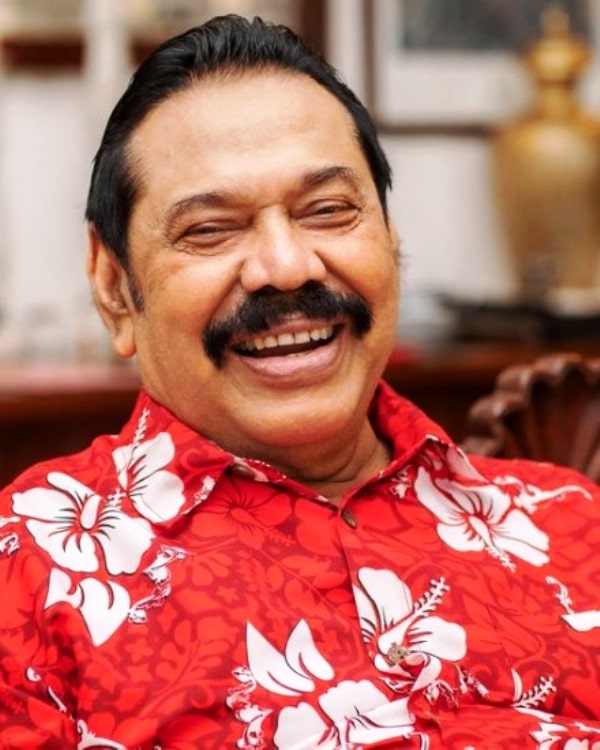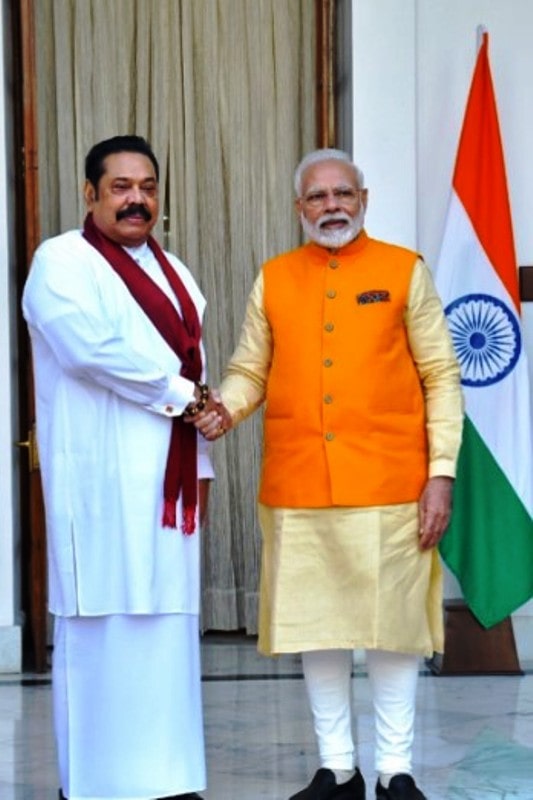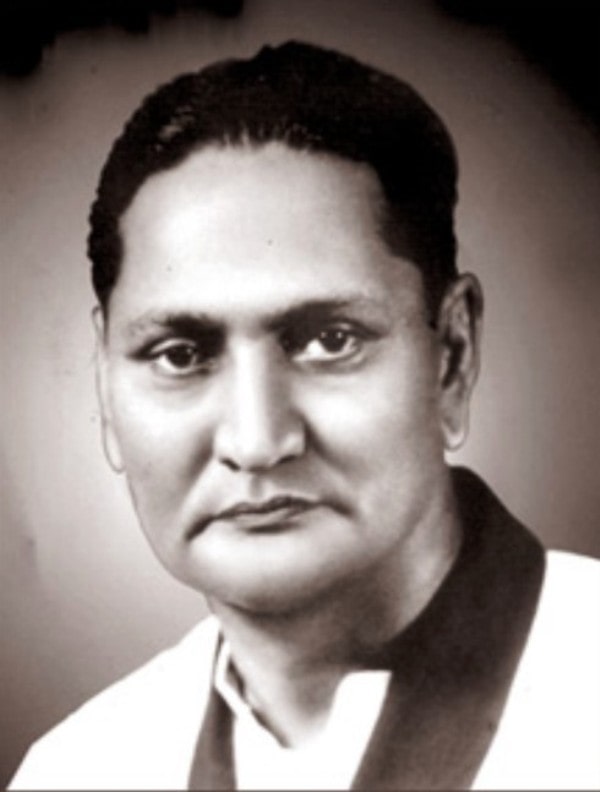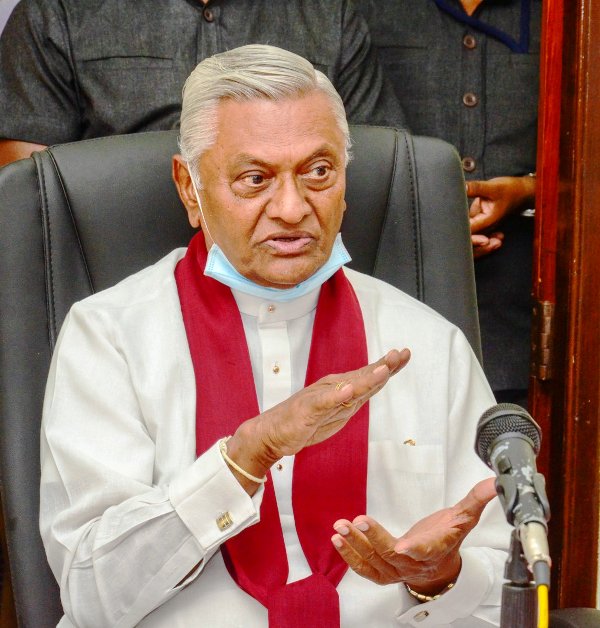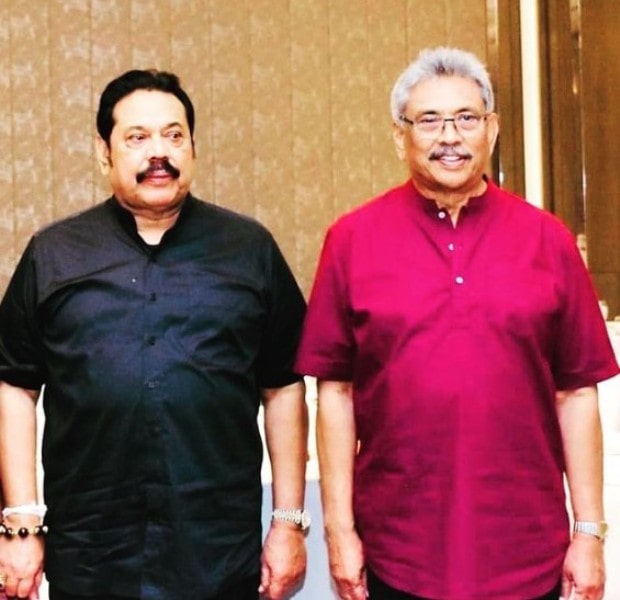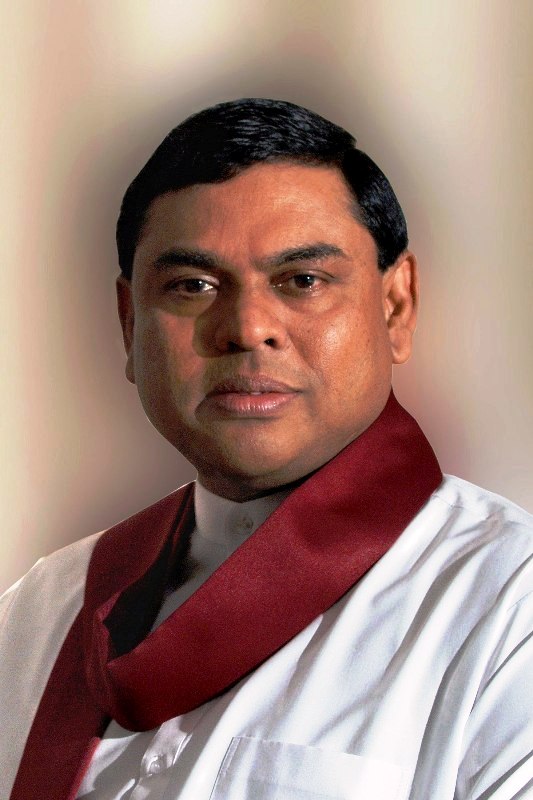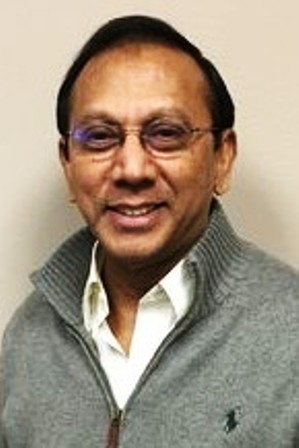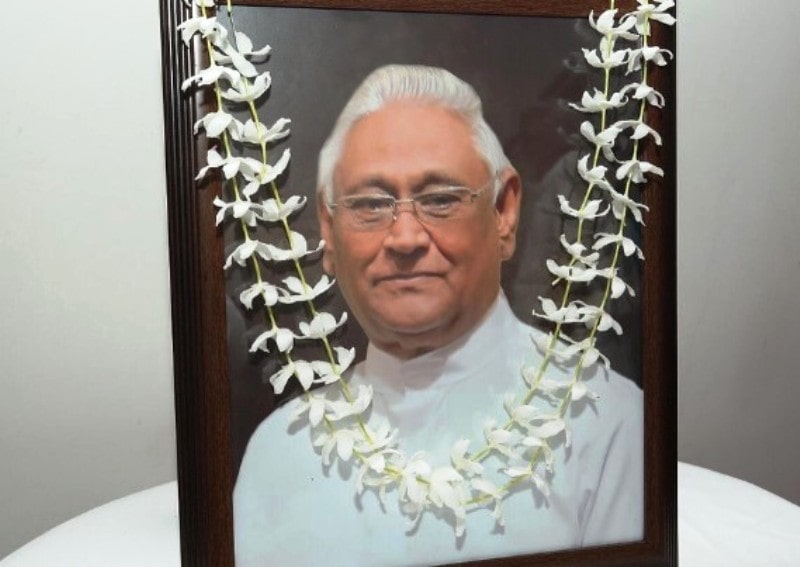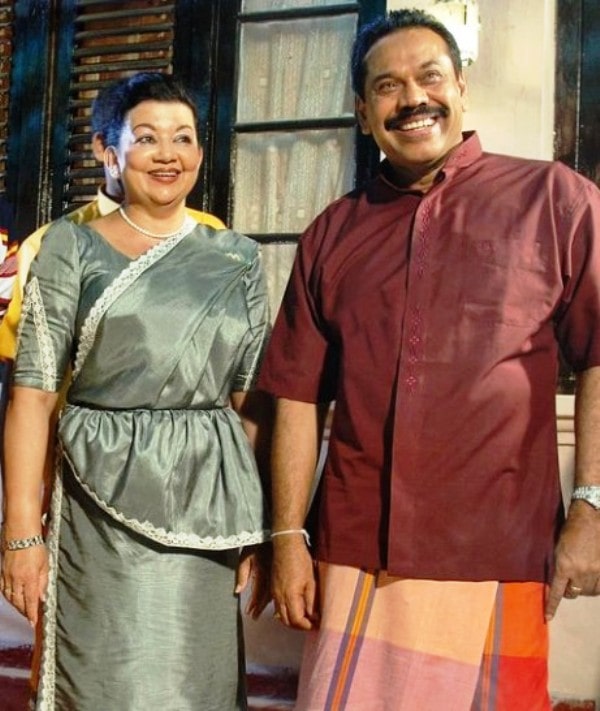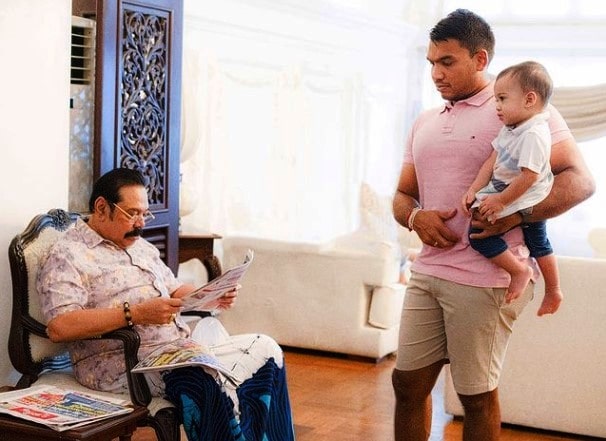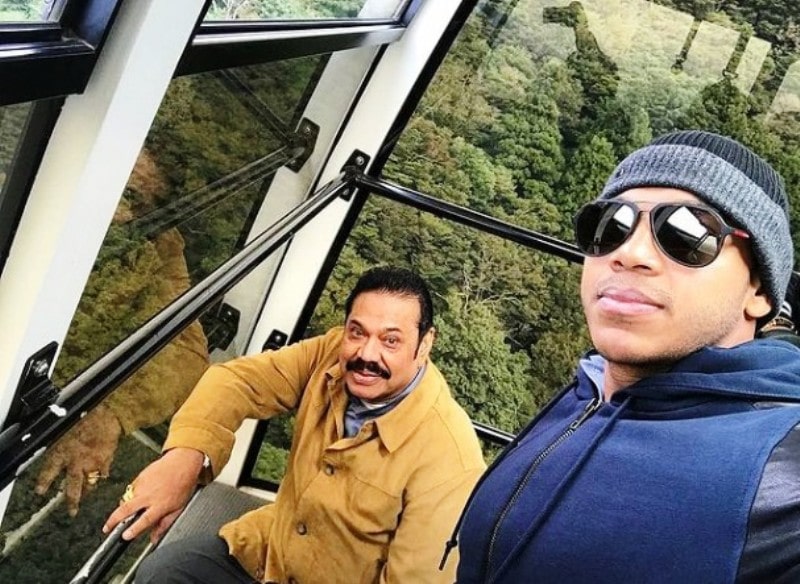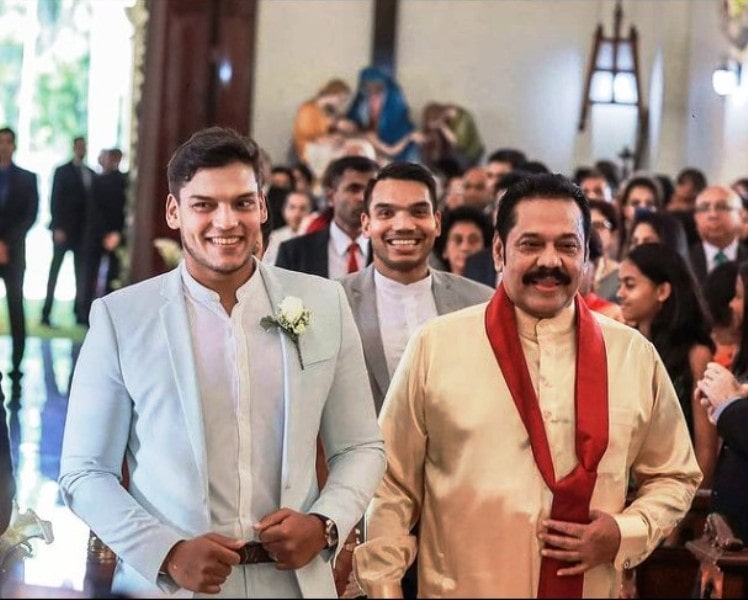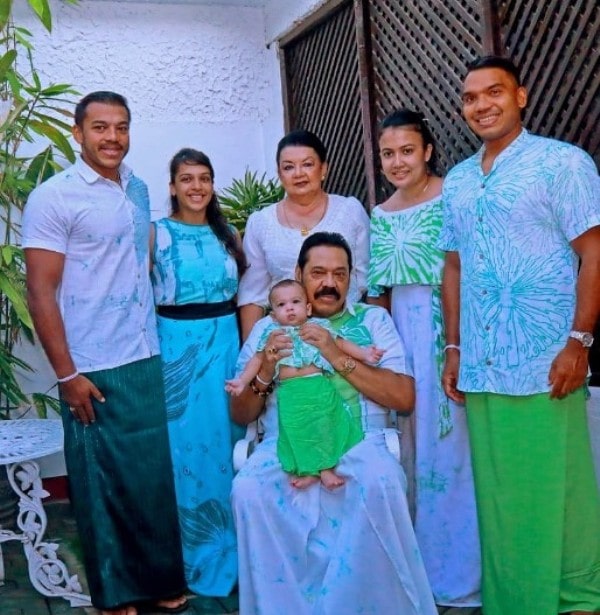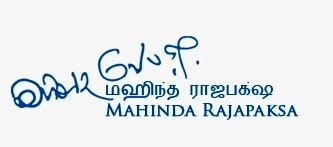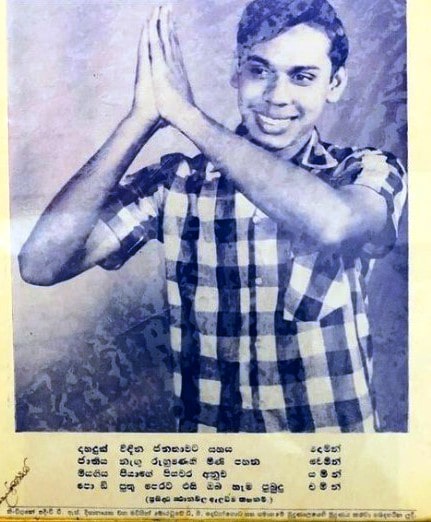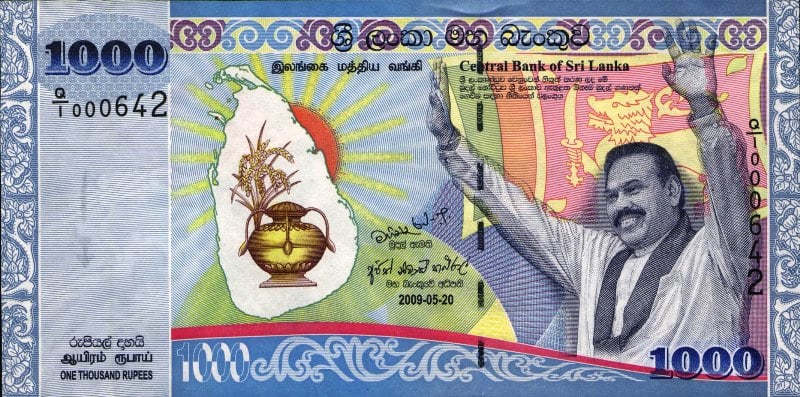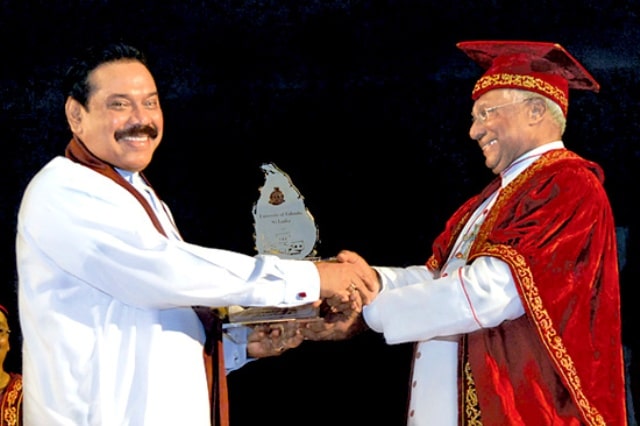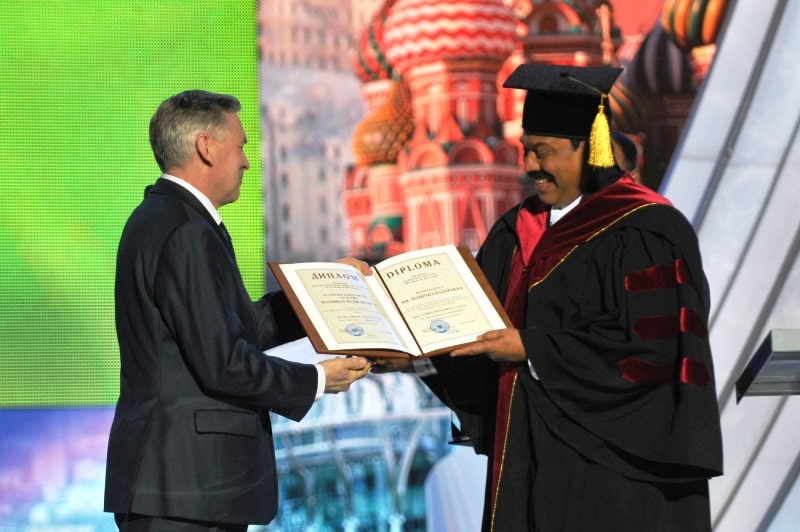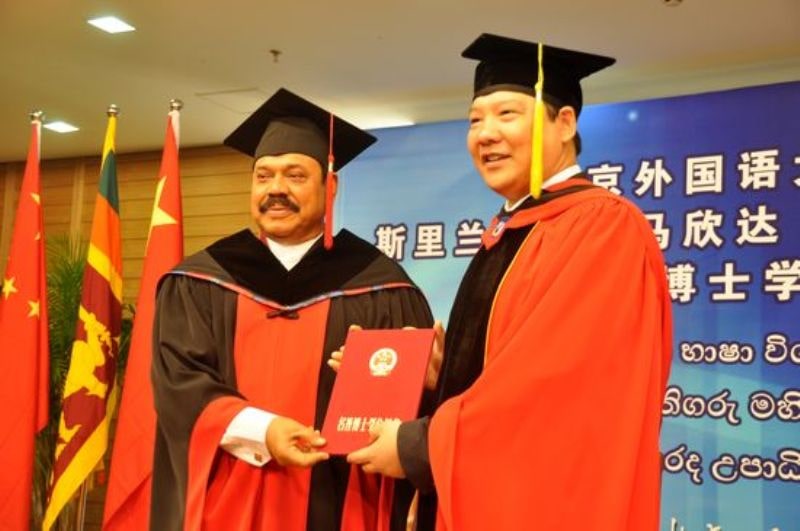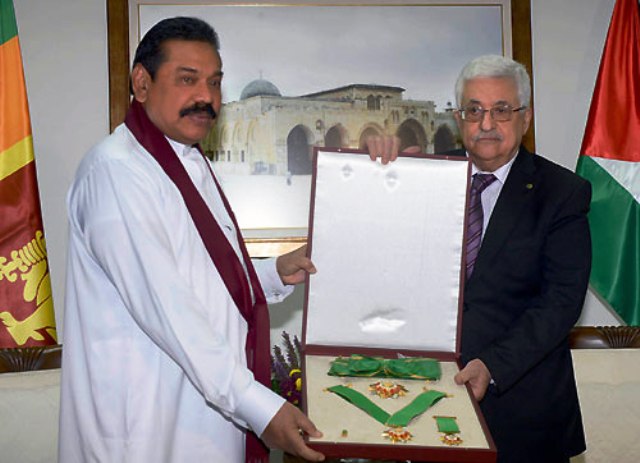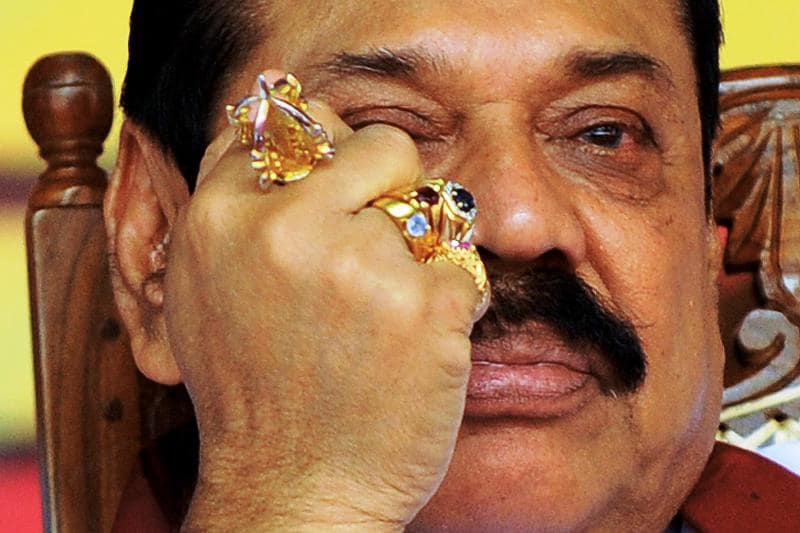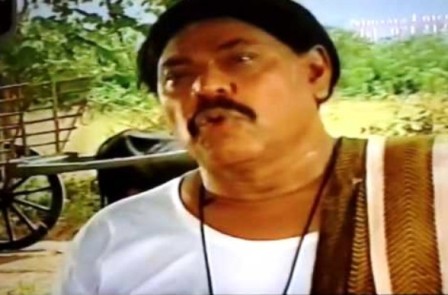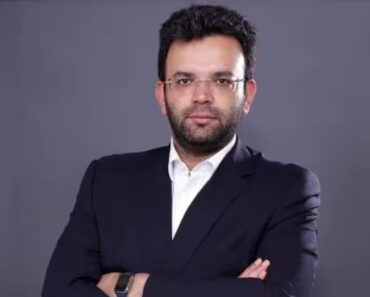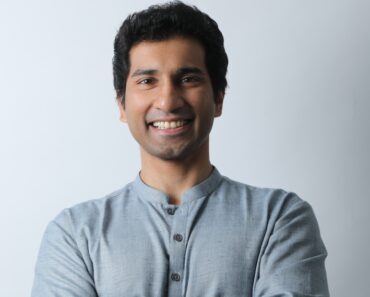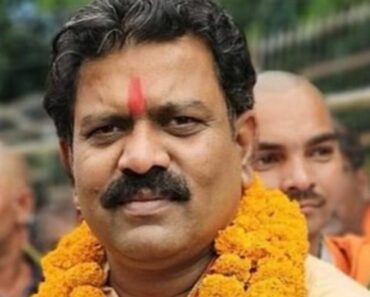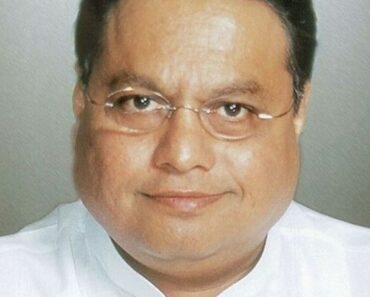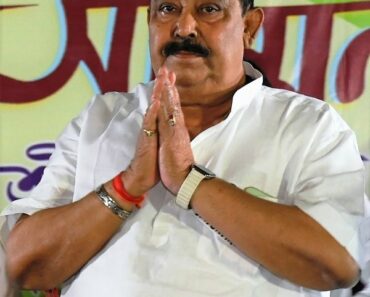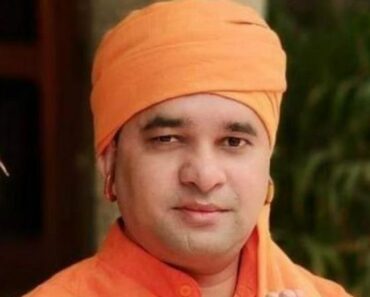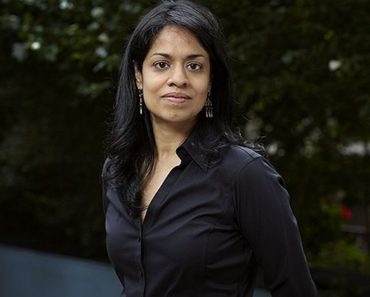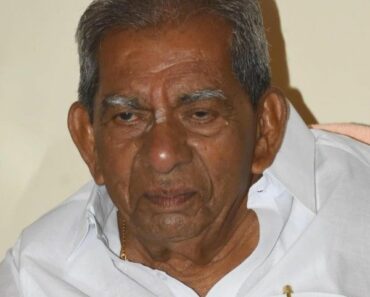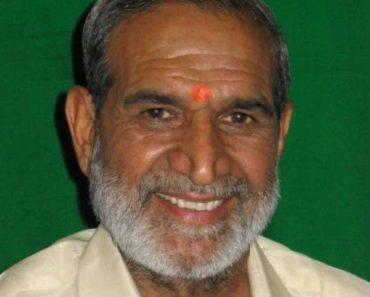Mahinda Rajapaksa is a Sri Lankan politician and lawyer. He was the 6th President of Sri Lanka, who held the office from 2005 to 2015. He is also known to be the elder brother of Gotabaya Rajapaksa, who fled Sri Lanka during the Sri Lankan crisis in 2022.
Contents
Wiki/Biography
Percy Mahinda Rajapaksa was born on Sunday, 18 November 1945 (age 77 years; as of 2022) in Weeraketiya, Southern Province, British Ceylon (now Sri Lanka). [1]The Wire After completing his schooling at Richmond School, Nalanda College, and Thurstan College, Mahinda enrolled at the Colombo Law College (now known as Sri Lanka Law College), where he earned a bachelor’s degree in law in 1974. [2]Mahinda Rajapaksa’s official website
Physical Appearance
Height (approx.): 5′ 9″
Hair Colour: Salt and Pepper
Eye Colour: Dark Brown
Family
Mahinda Rajapaksa belongs to a Sri Lankan Sinhalese family. [3]Mahinda Rajapaksa’s official website
Parents & Siblings
His father, D. A. Rajapaksa, was a freedom fighter and a politician.
His mother’s name was Dandina Rajapaksa.
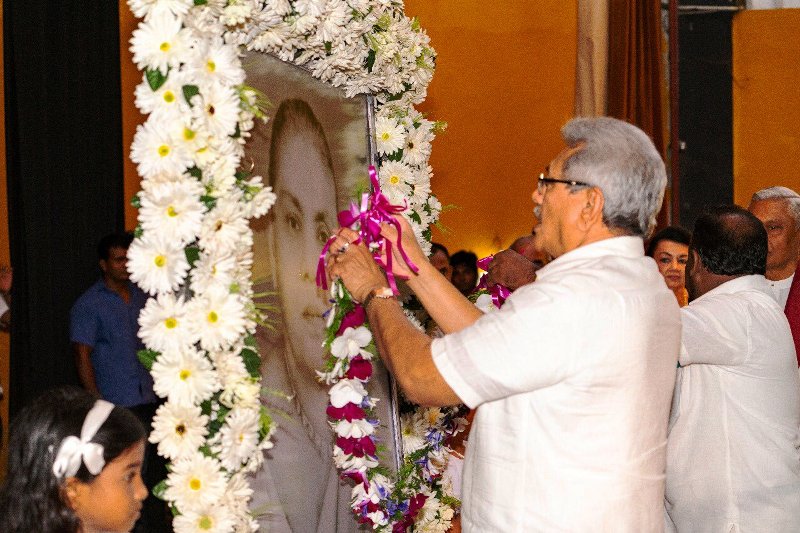
Gotabaya Rajapaksa, younger brother of Mahinda, offering a garland at his mother’s portrait during her death anniversary
Gotabaya Rajapaksa had eight siblings. Chamal Rajapaksa, the eldest of them all, was a former speaker of the Sri Lankan parliament and a lawyer.
His younger brother, Gotabaya Rajapaksa, was the former President of Sri Lanka, who fled the country in July 2022 amidst the economic crisis in Sri Lanka.
His younger brother, Basil Rajapaksa, is the former minister of finance and a former member of parliament.
His younger sister, Gandini Rajapaksa, died on 8 May 2017. His younger sister, Jayanthi Rajapaksa, is a former member of the Sri Lankan parliament and a former deputy minister, from 2010 to 2015, of water supply and drainage. His sister, Preethi Rajapaksa, was a teacher. His other sister’s name is Gandini Rajapaksa. His younger brother, Dudley Rajapaksa, is a vice president of QA/RA/Technical Service at Berlin Heart GmbH.
His brother, Chandra Tudor Rajapaksa, died in July 2022.
Wife & Children
His wife, Shiranthi Rajapaksa, is a psychologist, former Sri Lankan model, and the former first lady of Sri Lanka. The couple got married to each other in 1983.
He has three sons. His eldest son, Lakshman Namal Rajapaksa, is a politician.
His son, Yoshitha Kanishka Rajapaksa, is an officer in the Sri Lankan Navy.
His youngest son, Chandana Rohitha Rajapaksa, is an athlete and musician.
Religion
Mahinda Rajapaksa follows Buddhism. [4]ThePrint
Address
He resides at House No. 117, Wijerama Road, Colombo 07, Sri Lanka.
Signature/Autograph
Political Career
Member of Parliament and Ministerial appointments
Mahinda Rajapaksa’s political journey began in the early 1960s when he used to work as an assistant librarian at the University of Sri Jayewardenepura, where he read many books on politics and began to align himself with left-wing politics. Mahinda joined the Ceylon Mercantile Union after leaving his assistant librarian’s job, where he was made the union’s branch secretary in 1967. In 1968, after his father died, Mahinda joined the Sri Lanka Freedom Party (SLFP) and replaced his father as a party organiser. In 1970, Mahinda Rajapaksa contested the Sri Lankan parliamentary elections from the Beliatta constituency, where Mahinda defeated the United National Party (UNP) candidate, Dr Ranjit Atapattu, by a margin of 6,626 votes and entered the Sri Lankan parliament at the age of 24.
From 1970 to 1977, Mahinda remained a member of the parliament as a backbencher (an MP who does not hold any appointment in the governing party). In 1977, Mahinda contested the general elections in Sri Lanka from the Beliatta constituency; however, he lost to his UNP opponent Dr Ranjit Atapattu by a margin of 6,393 votes. In 1989, Mahinda Rajapaksa again contested the general elections from the Hambantota constituency, where he secured a victory and once again entered the parliament as its member. During the Janatha Vimukthi Peramunap (JVP) insurrection from 1987 to 1989, Mahinda Rajapaksa, as a member of the parliament, demanded the intervention of a foreign power to curb the alleged human rights violations that were taking place in Sri Lanka during UNP’s rule. He even went to the United Nations and Amnesty International to complain about the UNP’s role in violating human rights in Sri Lanka in the name of counter-insurgency operations. Talking about it, Mahinda, during an interview, said,
If the government is going to deny human rights, we should go not only to Geneva, but to any place in the world, or to hell if necessary, and act against the government sponsored human rights violations. The lamentation of this country’s innocents should be raised anywhere.”
In 1994, Mahinda Rajapaksa contested the general election in Sri Lanka and emerged victorious after which he was appointed as a cabinet minister and given charge of the Ministry of Labour. He held the post till 1997. In 1997, following the cabinet’s reshuffling, Mahinda was appointed the minister of Fisheries and Aquatic Resources. He held the portfolio till 2001. In 2001, Mahinda Rajapaksa contested the parliamentary elections in which he secured a victory; however, his party, Sri Lanka Freedom Party (SLFP), was defeated in the elections by the United National Party (UNP) as a result of which Mahinda could not become a minister. In 2004, after the UNP-led Sri Lankan government was dissolved by the then President of Sri Lanka Chandrika Kumaratunga, general elections took place in Sri Lanka in which not only did Mahinda win the elections but also the Sri Lanka Freedom Party managed to secure a majority in the parliament. After the SLFP established its government in Sri Lanka, Mahinda Rajapaksa became Sri Lanka’s 13th Prime Minister on 6 April 2004. Later, in 2004, he was given additional charge of the Ministry of Highways, Ports & Shipping.
Becoming the President for the first time (2005-2010)
For the 2005 Presidential elections in Sri Lanka, the Sri Lanka Freedom Party (SLFP) chose Mahinda Rajapaksa as its Presidential candidate against the United National Party (UNP) candidate Ranil Wickremesinghe. In the elections, Mahinda secured a victory over Ranil by a margin of 1,90,000 votes. After the elections, Ranil Wickremesinghe claimed that Mahinda Rajapaksa won the Presidential elections as the LTTE had issued an ultimatum in the Northern and the Eastern parts of Sri Lanka to boycott the Presidential elections as a result of which the Tamil population, a minority in those areas, could not cast their votes. [5]The Guardian Expressing his dissatisfaction over the entire electoral process, Ranil Wickremesinghe said,
It is a setback for the peace process as you have a very divided society. There is no Sri Lankan mandate but a divided one. I have demanded a recount of the vote in parts of the country where Tamil militants had prevented an estimated 500,000 voters from reaching polling stations, but the request was rejected by Sri Lanka’s elections commissioner.”
After becoming the President, Mahinda Rajapaksa took over the charge of the Ministry of Defence (MoD) and the Ministry of Finance (MoF). [6]BBC On 23 November 2005, he appointed his brother Gotabaya Rajapaksa as a permanent defence secretary and extended the service of lieutenant general Sarath Fonseka. According to the media, Sarath and Gotabaya played a vital role in leading Sri Lanka towards victory over the rebel faction Liberation Tigers of Tamil Eelam (LTTE).
War against the LTTE
In 2006, the LTTE killed several civilians and off-duty military personnel. They also attacked and captured the Mavil Aru reservoir and closed the water supply from the reservoir, which affected approximately 15,000 people living in the Eastern Province of Sri Lanka. After the LTTE captured the water reservoir, the Sri Lankan government scrapped the peace treaty, which was signed between the UNP-led Sri Lankan government and the LTTE in 2002. After the peace accord was scrapped, the Sri Lankan government ordered the Sri Lankan military to launch an assault on the LTTE across Sri Lanka. According to several sources, the military crackdown was so efficient that by the beginning of 2009, the Sri Lankan military had recaptured 95% per cent of the areas that were previously under LTTE’s control, and by 18 May 2009, the LTTE was defeated by the Sri Lankan military. While addressing the parliament after the government’s victory over LTTE, Mahinda Rajapaksa said,
We have liberated the whole country from LTTE’s terrorism. Our intention was to save the Tamil people from the cruel grip of the LTTE. We all must now live as equals in this free country. We must find a homegrown solution to this conflict. That solution should be acceptable to all the communities. We have to find a solution based on the philosophy of Buddhism.” [7]The Guardian
Second Presidency (2010-2015)
In 2010, the UNP-led coalition selected Sarath Fonseka, the former Sri Lankan Army commander, as the Presidential candidate against Mahinda Rajapaksa; however, Rajapaksa managed to defeat Sarath in the elections and became the President for the second time. According to several sources, after getting appointed to the Presidentship for the second time, Mahinda had Sarath Fonseka arrested and jailed for two years. As President, Mahinda implemented several infrastructural projects like Colombo Lotus Tower, Magampura Mahinda Rajapaksa Port, the Colombo Harbour South Container Terminal, the Mattala Rajapaksa International Airport, the Colombo-Katunayake Expressway, and the Mahinda Rajapaksa International Cricket Stadium throughout the country. Several media sources claimed that the implementation of such projects improved Sri Lanka’s ranking on the Human Development Index (HDI). Mahinda Rajapaksa also initiated several projects that focused on improving the existing roadways and highways in the country; however, several sources claimed that the implementation of such large-scale projects in the country resulted in rampant corruption, which increased the total cost of construction of the roads due to which the government had to take massive amounts of loan from China.
Post-Presidency
In 2015, Mahinda Rajapaksa contested and lost the Presidential elections in Sri Lanka against Maithripala Yapa Sirisena. Reportedly, Sirisena was supported in the elections by Ranil Wickremesinghe. After Sirisena won the Presidential elections, several sources reported that he wanted to appoint Mahinda as the Prime Minister of Sri Lanka; however, in the 2015 Parliamentary elections in Sri Lanka, the SLFP lost to Ranil Wickremesinghe-led United National Party (UNP) as a result of which Sirisena had to appoint Ranil Wickremesinghe as the Prime Minister of Sri Lanka. Even though his party lost the 2015 general elections, Mahinda entered the Sri Lankan parliament as its member as he had secured a victory in the polls from the Kurunegala constituency.
Leaving Sri Lankan Freedom Party
In 2016, the supporters of Mahinda Rajapaksa left the SLFP and made a new party due to a rift between Mahinda and SLFP’s leadership. The supporters founded the Sri Lanka Podujana Peramuna (SLPP) in 2016 and appointed Mahinda as its chairperson. While talking about it, a supporter of Mahinda, during an interview, said,
In the wake of the Central Bank bond scandal, the whole SLFP machinery is preoccupied with defending the Prime Minister. The sole aim of the SLFP today is to help the UNP to stay in power. It is the Sri Lanka Podujana Peramuna which will now truly embody the SLFP identity and character. He is our vision. He is the true leader in our hearts. We are his followers. These are his aspirations we are trying to fulfill. There are 36,000 villages in this country. All of them will rise in support of us.”
After becoming the chairman of SLPP, Mahinda Rajapaksa adopted an aggressive anti-China policy and demanded the withdrawal of the Chinese corporations that had invested approximately $5 billion in the Southern Economic Development Zone (SEDZ) in Sri Lanka. In 2017, despite the Sri Lankan Supreme Court’s orders, Mahinda Rajapaksa led the protests against the Chinese during the inauguration of the Hambantota-China-Sri Lanka Industrial Zone, where the SLPP not only pelted stones at the guests present at the inauguration ceremony but also at the then-Chinese ambassador to Sri Lanka, Yi Xiangliang.
The constitutional crisis in Sri Lanka
In 2018, after the SLPP defeated Ranil Wickremesinghe-led UNP at the local level elections by winning 239 out of 340 government bodies, the SLPP demanded that the President should remove the ruling UNP government from power. UNP’s defeat in the local elections also led to resentment among the UNP members of parliament, who demanded that Ranil must step down from the post of Prime Minister. The then President of Sri Lanka, Maithripala Sirisena, also asked Ranil Wickremesinghe to resign from the appointment; however, Ranil rejected the request of the President. On the evening of 26 October 2018, Ranil Wickremesinghe was informed by the President about his removal from office and the appointment of Mahinda Rajapaksa as the new Prime Minister. Ranil called Mahinda Rajapaksa’s appointment unconstitutional, and he refused to resign from the post. Since there were two in-office Prime Ministers in 2018, this triggered a constitutional crisis in Sri Lanka. [8]Scroll.in Following the unlawful removal from the office, Ranil Wickremesinghe filed litigation in the Supreme Court. On 16 December 2018, the court delivered its judgement in favour of Ranil and asked the President to reinstate him as the Prime Minister of Sri Lanka. After Mahinda became the Prime Minister, he not only failed to gather the support of the MPs but also failed to pass the motion of confidence, which resulted in Mahinda resigning from the Prime Minister’s office on 15 December 2018. On 1 January 2019, Ranil Wickremesinghe was re-appointed as the Prime Minister of Sri Lanka and began his fifth tenure as the Prime Minister. [9]Reuters Talking about the crisis, Ranil said,
It is a victory for Sri Lanka’s democratic institutions and the sovereignty of our citizens. I thank everyone who stood firm in defending the constitution and ensuring the triumph of democracy. I will work for a better economic situation, better standard of living for Sri Lankans after first working to normalize the country.”
After resigning from the office of the Prime Minister, Mahinda Rajapaksa was appointed the leader of the opposition in the Sri Lankan parliament on 18 December 2018.
Prime Minister of Sri Lanka (2020-2022)
In 2019, Gotabaya Rajapaksa won the Presidential elections in Sri Lanka and was sworn in as the 8th President of Sri Lanka. In 2020, Sri Lanka Podujana Peramuna (SLPP) secured a landslide victory against the UNP in the Sri Lankan general elections following which Gotabaya Rajapaksa appointed Mahinda Rajapaksa as the Prime Minister of Sri Lanka. With Mahinda as the Prime Minister and Gotabaya as the President, Sri Lanka became the second country after Poland, where blood relatives held top political posts in a country. [10]Fox News
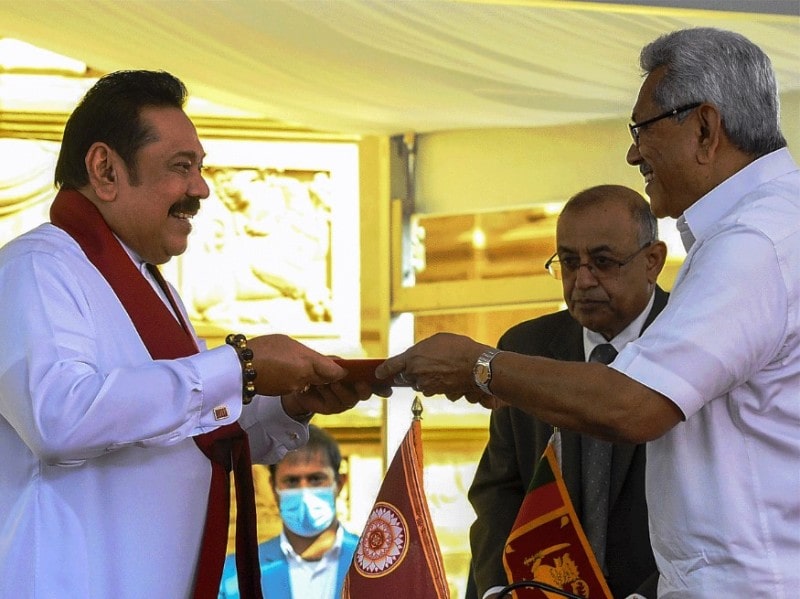
Mahinda Rajapaksa (left) handing over documents to Gotabaya Rajapaksa after taking oath as the Prime Minister of Sri Lanka
After the 2020 general elections in Sri Lanka, five members of the Rajapaksa family were elected as members of parliament. In 2022, the Rajapaksa-led Sri Lankan administration implemented several faulty policies that resulted in the economic downfall of Sri Lanka and its declaration as a sovereign default. On 9 May 2022, following violent protests in Sri Lanka, Mahinda Rajapaksa resigned from the post of Prime Minister and shifted to a naval base in Trincomalee for security purposes. [11]Newsfirst.lk
Controversies
Accusations of adopting malpractices during the elections
In 2005, Ranil Wickremesinghe, the leader of the United National Party (UNP), accused Mahinda Rajapaksa of winning the Presidential election in Sri Lanka by paying a large amount of money to the rebel faction LTTE to issue an ultimatum to the Tamil populace living in the LTTE dominated areas against casting their vote during the elections. [12]BBC In March 2010, during an interview with Ada Derana, Amarasinghe, a JVP member, claimed that while having a meal with Mahinda Rajapaksa, he claimed to have won the 2010 Presidential elections by manipulating the results with the help of computers. Talking about it, Amarsinghe said,
It is not my statement. It is in fact Mahinda’s. I just repeated that if he was capable of doing such a computer jilmaart to top the district preference votes, he may have done something similar to that computer jilmaart to become the top in the country as well.” [13]Ada Derana
In 2018, The New York Times published an article titled How China Got Sri Lanka to Cough Up a Port. In the article, the media house claimed that Mahinda Rajapaksa received $7.6 million from a China-based port building company named China Harbour Engineering Company for his 2015 Presidential election campaigning. The New York Times further claimed that during the last phase of the 2015 Presidential elections, the then-Chinese ambassador to Sri Lanka, Yi Xianliang, lobbied for Mahinda to further the interests of China in Sri Lanka. The article also presented a breakdown of the amount of money spent by Mahinda on his election. According to The New York Times, out of the $7.6 million, voters received approximately $3.7 million in cash, and about $6,78,000 was spent on printing t-shirts and other merchandise for the election campaigning. Additionally, Mahinda spent around $2,97,000 on purchasing gifts for his supporters. The article also claimed that Mahinda paid $38,000 to the Buddhist monks who supported his Presidential bid and paid a total of $1.7 million to the SLFP volunteers. [14]The New York Times While responding to the allegations, Mahinda told the Colombo Telegraph that the allegations levied against him were the United National Party’s campaign to malign his image. Talking about the allegations, Mahinda said,
If any election campaign contributions had been made to me by China Harbour Co, the Port City contract would not have been restored to them and neither would they have been allowed to bid for the lease of the Hambantota harbour. The NYT writer has stated that they had obtained some of the details in that article from a Sri Lankan government investigation. Every Sri Lankan knows that the main preoccupation of this government since it came into power has been to sling mud at the opposition.” [15]Colombo Telegraph
Contrary to the claims of Mahinda, the Colombo International Container Terminals Limited (CICT), a corporation jointly owned by Sri Lanka and China, claimed that they deposited Rs 20 million into the bank account of Mahinda Rajapaksa’s sister-in-law Pushpa Rajapaksa in 2018. [16]Business Standard
Accused of kidnapping and assaulting a Sri Lankan journalist
Keith Noyahr was a Sri Lankan journalist who was abducted in 2008. In 2018, the Sri Lankan Criminal Investigations Department (CID) questioned Mahinda about the kidnapping. Reportedly, the CID questioned Mahinda after establishing a connection between Mahinda and the kidnapping of Keith. According to the CID, a few days before Keith was released by his kidnappers, Mahinda received phone calls from Karu Jayasuriya and Lalith Alahakoon, the prime suspects of plotting Keith’s kidnapping; however, Mahinda denied receiving any phone call and called it a conspiracy by the political parties to take revenge. [17]Daily Mirror Talking about his abduction, Keith told the court,
While serving as Deputy Editor of The Nation in 2008, I had published a series of articles flagging weaknesses in the government and military. A day after these articles were published, while I was travelling towards the University of Colombo, I noticed that I was being followed by Army jeeps and had to escape them by entering the university premises. On the same night, an armed group who arrived in a white van had beaten, blindfolded and abducted me. I was beaten throughout the journey in the van and was questioned on whether I had any links with the LTTE. After which I was taken to an unknown location, stripped, suspended mid-air and beaten once again.” [18]Newsfirst.lk
Allegations of human rights violations during the Sri Lankan civil war
In 2010, WikiLeaks declassified a series of messages sent by the then US Ambassador to Sri Lanka Patricia A. Butenis to the Pentagon in which she claimed that Mahinda Gotabaya, as President of Sri Lanka, was involved in the massacre of the Tamil populace during the Sri Lankan civil war. Patricia, in her messages, also claimed that Mahinda was also involved in killing the LTTE rebels, who were under the custody of the Sri Lankan forces after the end of the war. Talking about it, Patricia A. Butenis said,
There are no examples we know of a regime undertaking wholesale investigations of its own troops or senior officials for war crimes while that regime or government remained in power. In Sri Lanka this is further complicated by the fact that responsibility for many of the alleged crimes rests with the country’s senior civilian and military leadership, including President (Rajapaksa) and his brothers and opposition candidate General Fonseka.” [19]The Telegraph
After the war between the Sri Lankan government and the LTTE ended in 2009, the UN, under the leadership of Ban Ki-moon, established a task force to investigate cases related to human rights violations in Sri Lanka. The task force submitted its report to the United Nations Human Rights Council (UNHRC) in 2011. In its report, the task force claimed that during the civil war in Sri Lanka, the LTTE and Sri Lankan military engaged in a series of human rights violations across Sri Lanka. The report also claimed that the Sri Lankan military knowingly bombarded the areas where the civilian population lived. The report further said that the Sri Lankan authorities denied humanitarian assistance to the civilians stuck in the war zones, which led to the death of more than 40,000 people during the war. According to the UN, when it asked the Sri Lankan government to respond to the allegations, the government produced its report against the UN and did not reply to the original report published by the UN. [20]ReliefWeb In the same year, the British news channel named Channel 4 News published an article titled “The Sri Lankan soldiers whose hearts turned to stone” in which they briefly talked about the violations of human rights in Sri Lanka by the hands of the Sri Lankan military. In its article, the news agency quoted a former Sri Lankan Army officer revealing how the Sri Lankan Army committed atrocities on the civilian population in the name of counter-insurgency operations. He also said that the Sri Lankan government allowed the army to conduct operations with complete impunity. Talking about it, he said,
When I look at it as an outsider I think they’re simply brutal beasts. Their hearts are like that of animals, with no sense of humanity. If they wanted to rape a Tamil girl, they could just beat her and do it. If her parents tried to stop them, they could beat them or kill them. It was their empire. For the soldiers at the battlefront, their hearts had turned to stone. Having seen blood, killings and death for so long, they had lost their sense of humanity. I would say they had turned into vampires.” [21]Channel 4 News
In 2012, the same news channel published a documentary titled Sri Lanka’s Killing Fields. In the documentary, the news channel claimed that according to the revelations made by the whistleblowers in the Sri Lankan government, many female LTTE rebels were either sexually assaulted or beaten mercilessly before being murdered. [22]Channel 4 News Responding to the allegations, the Mahinda Rajapaksa-led Sri Lankan government denied the allegations as false and baseless and said that the war atrocities were committed by the LTTE and not the Sri Lankan Armed Forces.
Bribery and corruption
In 2012, the Transparency International Corruption Index (TICI) published a report in which it claimed that the Sri Lankan government had spent nearly Rs. 3,000,000,000 on an exhibition. As per the report, the money used in the exhibition was siphoned by the Sri Lankan government from a multi-billion dollar road project that was to take place in Sri Lanka. In 2015, Mahinda was accused of not paying the state-run Independent Television Network (ITN) for running his 2015 Presidential election campaign ads, which led to the ITN incurring massive losses. After the allegations, President Sirisena constituted a Presidential Commission of Inquiry (PCI) to investigate the allegations. Mahinda, in his defence, said that the commission was unconstitutional as the President had gone against the Sri Lankan constitution by appointing four high court judges in the PCI and challenged it in the Court of Appeal. Talking to the media about the issue, Mahinda Rajapaksa’s lawyers said,
We have objected to the functioning of the commission and that it was unconstitutional to make this commission as four serving High Court judges could not be appointed to carry out other duties such as functioning as members of the commission.”
Responding to the petition of Mahinda, the judge of the Court of Appeals said that according to the Sri Lankan constitution, the President could appoint the judges of a high court in his constituted commissions. In the judgement, the judge stated,
Under the Article 110 of the Sri Lankan Constitution, the President can appoint High Court judges for other duties. There is no mention in the Constitution that High Court judges cannot be appointed to the commission.” [23]Daily FT
On 13 January 2015, Janatha Vimukthi Peramuna (JVP), a political party of Sri Lanka, filed an affidavit against Mahinda, Gotbaya, and Basil at the Bribery and Corruption Commission (BCC) and accused the trio of receiving kickbacks while signing several deals with the Chinese government. While talking about the litigation, the spokesperson of the JVP said,
The main objective of our complaint is to ensure that the Mr Rajapaksa family is brought to justice. We want to prevent them from fleeing the country and escaping justice. A total of 12 individuals have been named in the complaint as alleged offenders including former finance secretary Punchi Banda Jayasundera and ex-central bank governor Nivard Cabraal. They have been accused of foreign exchange fraud, land grabs and misusing state property.” [24]The Straits Times
On 16 January 2015, following the filing of the affidavit, President Sirisena constituted a commission to investigate the cases of corruption against the three brothers. He also suspended the contracts signed between the Rajapaksa government and the Chinese government until the investigations were over. In February 2015, Ranil Wickremesinghe, as the Prime Minister of Sri Lanka, established an anti-corruption unit named Financial Crimes Investigation Division (FCID) to investigate the matters related to corruption, stock market price-fixing, and the abuse of state funds by the Rajapaksa family. A few months after establishing the FCID, Basil Rajapaksa, younger brother of Mahinda Rajapaksa, was arrested on the charges of laundering $ 5,30,000 while serving as the Minister of Economic Development. [25]BBC Talking about his arrest, Basil told the media,
They have no evidence. They are making wild allegations. This is a witch hunt. Neither I nor any member of my family has ill-gotten money.”
In 2015, it was reported that the Sri Lankan Air Force issued a gazette notification in which it revealed that during the 2015 Presidential election, Mahinda Rajapaksa used Sri Lankan Air Force’s helicopters for his personal use and spent $17,300 (Rs. 2,278,000) of the taxpayers’ money to travel to conduct rallies. The SLAF also claimed that the helicopters were not only used by Mahinda but also by his family and close associates. In 2015, after the Sri Lankan Freedom Party lost its elections and the United National Party formed its government in Sri Lanka, the UNP accused Mahinda Rajapaksa of laundering approximately $5.31 billion (Rs 700 billion) outside Sri Lanka. On 8 January 2015, the Sri Lankan government established a task force to investigate the Rajapaksa family’s money laundering case. The government also claimed that the Rajapaksa family siphoned the money away from Sri Lanka with the help of the governor of the Central Bank of Sri Lankan (CBSL), who was a close associate of the family. Talking about it, Rajitha Senarathne, the cabinet’s spokesperson, said
You all know about this black money and these hidden foreign assets. We are aware of these. We will provide all the information, whatever is available to us, to a special investigation unit. The government has information that some of the black money belongs to big people who were very powerful in the hierarchy of the previous government.” [26]Reuters
Allegations of attempting a coup in Sri Lanka
In 2015, the former Sri Lankan member of the parliament Athuraliye Rathana Thero accused Mahinda of attempting a coup d’état after losing the 2015 Presidential elections to Sirisena. In the same year, members of the parliament Rajitha Senaratne and Mangala Samaraweera claimed that Mahinda Rajapaksa went to the Sri Lankan Army chief Jagath Jayasuriya and requested him to join the coup; however, the army chief refused to be a part of the coup. They further said that Mahinda also requested the then Attorney General of Sri Lanka to prepare the documents to implement an emergency in Sri Lanka, which was denied by the Attorney General. [27]Oneindia Tamil Later, in 2015, President Maithripala Sirisena ordered a probe into the allegations following which the Ranil Wickremesinghe-led UNP government also accused Mahinda and his supporters of trying to seize control of the polling booths in Sri Lanka. [28]BBC Talking about it, the spokesperson of the UNP said,
We have credible information that the Army Commander, Police Chief and Attorney General were called to the Temple Trees at 1.00 a.m. on Friday and checked with them a way to stop counting of votes immediately when the two knew that they were losing the election. Fortunately, the Army Commander and the IGP have told Mahinda and Gotabaya in no uncertain terms that they could not be a party to this illegal attempt and not ready to give unlawful orders to men under their command. Attorney General has said the illegal and unconstitutional action will have extremely dangerous repercussions. The modus operandi of the two brothers was to grab power through a military coup. The people of this country and the global community should know this.” [29]Daily Mirror
Adding to the allegations, in 2015, the former Sri Lankan Army commander Sarath Fonseka claimed that Mahinda had managed to rally the support of approximately 2000 soldiers of the Sri Lankan Army, who were ready to act according to the orders of Mahinda and begin a coup; however, the Sri Lankan Army and the police force rejected the allegations. In March 2015, the then ruling government’s cabinet spokesperson said that the accusations against Mahinda could not be proved due to lack of evidence. Later, Mahinda released an official statement in which he denied plotting a coup in Colombo and called the allegations baseless, misleading, and false. Talking about it, Mahinda said,
I deny in all possible terms reports of attempts to use the military to influence election results. I have always bowed down to the people’s verdict. This government wants to throw mud at me. I mean how can you start a coup with every other government being within two hours to thwart any attempt by me? I think they were speaking to Western governments and they had this idea about me.” [30]Ada Derana [31]The Hindu
Accused of promoting nepotism
According to the Sri Lankan media, Mahinda has often been accused of promoting nepotism by appointing his relatives to several important political and diplomatic posts. In 2005, after becoming the President of Sri Lanka, he appointed his younger brother Gotbaya Rajapaksa, who did not even contest the general elections in Sri Lanka, as a permanent defence secretary. After Mahinda was re-elected as the President for the second time in 2010, not only did he extend Gotabaya’s tenure as the defence secretary but also appointed his brother Basil Rajapaksa as the minister of finance. He also appointed his elder brother Chamal Rajapaksa as the speaker of the Sri Lankan parliament. Chamal served as the speaker from 2010 to 2015. Mahinda Rajapaksa has not only given important posts to his relatives in the country but has also given several important diplomatic posts to his relatives outside the country. [32]Groundviews – Journalism for Citizens
Dwindling freedom of journalism under his governance
According to several sources, when Mahinda served as the President of Sri Lanka from 2005 to 2015, the freedom of the Sri Lankan journalists was restricted by the ruling government. In 2010, according to a report published by Reporters Without Borders, Sri Lanka’s press freedom ranking stood at 158 out of 173 countries; however, several media houses in Sri Lanka rejected the report claiming it to be an exaggerated account. In 2011, The Sunday Leader published an article claiming that the 2010 report of Reporters Without Borders was unjustified because unlike Saudi Arabia, Sri Lanka never implemented a law that officially banned it from reporting sensitive issues. The report further said,
RSF’s 2010 Press Freedom Index has Sri Lanka at number 158, nearly tied with Saudi Arabia. This makes the rankings somewhat suspect. In Saudi Arabia, all newspapers are owned by the royal family or their associates. All TV and radio stations are government-owned. Saudi journalists are forbidden by law to criticise the royal family or religious authorities and writers and bloggers are routinely arrested. Sri Lanka is obviously not this bad.”
Marginalising the Tamils in Sri Lanka
The Sri Lankan media has often accused Mahinda Rajapaksa of implementing policies that have sidelined the Tamil population living in Sri Lanka. In 2014, the Tamil National Alliance (TNA) accused Mahinda of allowing a Buddhist extremist faction named Bodu Bala Sena to attack the Tamils and Muslims in Sri Lanka. The TNA further alleged that Gotabaya, Mahinda’s younger brother, had openly supported the Buddhist extremist factions, an action to which Mahinda never objected. [33]Reuters Talking about it, the TNA, in its official statement, said,
The values of democracy, good governance, and rule of law have suffered unprecedented assault under Rajapaksa. Instead of pursuing reconciliation, the Rajapaksa regime has permitted extremist groups to carry out attacks against minority peoples and their places of religious worship.”
Rejecting the allegations against him, Mahinda Rajapaksa told the media that the creation of Bodu Bala Sena was a western conspiracy against him and his family. Talking about it, Mahinda said,
It is a Western-backed conspiracy to alienate minority Muslims and defeat his government. Look at where the BBS travelled (Norway and the US). It is clearly a (then) opposition project. I am a president for the whole nation. I divide people not as Sinhalese or Tamils or Muslims or Burghers [Lankan-Europeans]. I divide them into people who love the country and people who do not.” [34]Tamil Eelam Liberation Organization
While serving as the President of Sri Lanka, Mahinda Rajapaksa passed a bill in the Sri Lankan parliament which banned the Tamil version of the Sri Lankan national anthem that was originally written in the Sinhalese language; however, after Maithripala Sirisena became the President of Sri Lanka after winning the 2015 Presidential elections, the Sri Lankan government withdrew the law and allowed the Tamils to sing the national anthem in their language. [35]DNA India According to several media houses, Mahinda, even after losing the elections, was completely against the Sri Lankan government’s decision and said that “the national anthem should be sung in one language and not two or three languages.” [36]Colombo Gazette
Creating a cult in Sri Lanka
Several media sources claim that Mahinda Rajapaksa used religion and the war against the LTTE to his benefit to create a cult in the country around him. His loyalists also refer to him as the “King.” Reportedly, when Mahinda served as the President from 2005 to 2015, he would have young school children sing songs in his praise and the children would often refer to him as “the father of the country” and “our father” in the songs. Mahinda not only had his photo printed on the currency notes in Sri Lanka but also had several airlines named after him.
Several sources also claimed that while serving as the President of Sri Lanka, Mahinda had several infrastructural projects like Mattala Rajapaksa International Airport, Magampura Mahinda Rajapaksa Port, Nelum Pokuna Mahinda Rajapaksa Theatre, and Mahinda Rajapaksa International Stadium named after him. [37]Colombo Telegraph [38]Hindustan Times
Allegations of making contradictory statements by SAITM
In 2017, there were protests undertaken by medical students studying in government-owned institutes against the medical degrees given by private institutes like the South Asian Institute of Technology and Medicine (SAITM). Mahinda Rajapaksa not only supported the demands made by the medical students but also demanded that the Sri Lankan government should come up with a standard policy or else everyone in Sri Lanka would become a doctor through institutes like SAITM. In its defence, SAITM claimed that the former President made contradictory statements and that the institute was granted recognition by the University Grants Commission (UGC) when Mahinda Rajapaksa was serving as the President in 2013. The SAITM also claimed that during the rule of Mahinda, the institute gave scholarships worth Rs 7 million to those students who had scored good marks in biology but could not enter a state university to pursue a degree in medicine. [39]Newsfirst.lk [40]Ada Derana
Resorting to violence during the 2022 Sri Lankan crisis
After resigning as the Prime Minister of Sri Lanka, on 9 May 2022, Mahinda Rajapaksa ordered his loyalists to gather at his house, where he reportedly gave a speech to his supporters and asked them to disrupt the peaceful protests that were taking place outside his residence at the Temple Trees in Colombo. After his speech, Mahinda’s loyalists, armed with iron rods and clubs, brutally attacked the protestors chanting “Gota Go Home.” The loyalists even travelled to Galle Face, where they not only attacked the protestors protesting peacefully but also burnt their tents. The violent attacks on Sri Lankan citizens resulted in more than two hundred citizens being injured. Lashing out at the Rajapaskas, the former Sri Lankan cricketer Sanath Jayasuriya accused Mahinda and his brothers of orchestrating the violent attacks on the Sri Lankans. Talking about it, during an interview, Jayasuriya said,
I never thought that this type of thuggery will be unleashed on innocent protesters at galle face in broad day and outside temple trees. The police must remember they are here to protect the PUBLIC of this country not corrupt politicians. This is the end of the Rajapaksas.” [41]Hindustan Times [42]The Guardian
Awards, Honours, Achievements
- In 2004, Mahinda Rajapaksa was awarded the Nalanda Keerthi Sri by the Nalanda College.
- On 6 September 2009, Mahinda Rajapaksa was awarded an honorary doctorate in law by the University of Colombo.
- On 6 February 2010, the Peoples’ Friendship University of Russia presented Mahinda Rajapaksa with an honorary doctorate for contributing to world peace and outstanding success in defeating terrorism.
- In August 2011, the Beijing Language and Culture University (BLCU) awarded an honorary doctorate to Mahinda Rajapaksa.
- In 2014, the Palestinian government awarded the Order of the Star of Palestine medal to Mahinda Rajapaksa.
- In January 2022, the Visva Bharati University in India bestowed the title of Professor Emeritus on Mahinda Rajapaksa.
Car Collection
Mahinda Rajapaksa owns a vintage FIAT 124 Sports Coopé.
Net Worth
As of 2015, the net worth of the Rajapaksa family was approximately $18 billion (Rs 3.2 trillion). [43]Newsfirst.lk
Facts/Trivia
- According to several sources, Mahinda Rajapaksa extensively believes in astrology. He also wears many astrological rings for good fortune. The sources also claimed that Mahinda always takes advice from his trusted astrologers before making a decision. Reportedly, one of the astrological rings contains the hairs of an elephant for good luck.
- Reportedly, Mahinda Rajapaksa is known by many nicknames. For his love for the astrological rings, he is known as the lord of the rings, and the protestors in Sri Lanka call him a Mynah, a bird. [44]CNN-News 18 [45]EconomyNext
- In 1994, Mahinda Rajapaksa appeared in a Sinhalese film titled Nomiyena Minisun.
References

